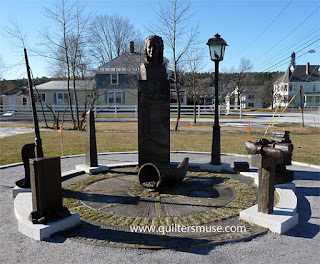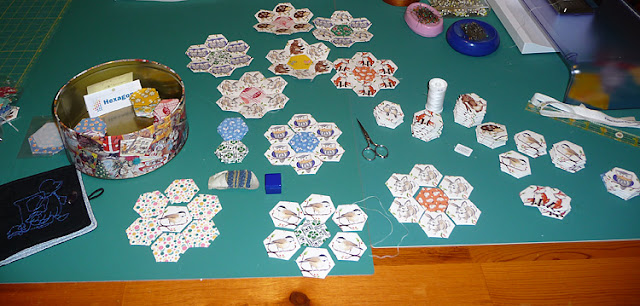Working with hexagons is a simple and fun process. All
that is needed are scraps of fabrics and pre-cut paper templates cut
in the shape of a hexagon. Today, we are very lucky to have a company
that makes white paper hexagons so that folks do not have to cut out
the shapes, one at a time, which is very time-consuming. The company
makes these hexagons in various sizes, and although I am not affiliated with them, I like their product so much, so I will tell
you the company name: "Paper Pieces." They sell their products online and in quilt shops.
 |
Portion of a 1930s quilts shows "Nile Green" color "paths" for the Grandmother's Flower Garden quilt
photo by James Cummings |
Paper Baste or Glue Baste?
I like the plastic templates sold by Nancy's Notions. They include the 1/4 inch seam allowance needed around the hexagon shape. Paper pieces can be cut out individually or pre-cut papers can be used. The fabric is placed right sides down and edges are turned under, one at a time, and glue basted
with a water soluble glue stick. Alternately, some folks like to baste with a needle and thread. After joining the hexagon units and assembling the finished project, remove the papers. If glue was used, spritz the glued areas with water using a spray bottle. Then, carefully
remove the softened papers with tweezers.
Where To Begin
Of course, we start with first preparing the 7
hexagons, one for the center, and six hexagons to add to the center,
working clockwise, or counter-clockwise, if you are left-handed.
Sew by Whipstitching
Use a long, thin needle and silk thread or a fine
cotton sewing thread to piece the units together. To begin, put two
prepared hexagons, right sides together, and whipstitch one edge.
Knot twice and cut thread.
Place another hexagon, right sides together, on top of
the center hexagon and again whipstitch along one edge and
then down the middle of the two added hexagons. Tie off. Continue working in
this manner until a “rosette” is formed. The next “row” will have 12 hexagons and can
be a solid color to form “paths” between rosette units. The next "row" will be incrementally larger.
Book Inspires Projects
Janet Elwin of Maine was one of the first to write
about hexagons in the late 20th century. They inspired her to make
all sorts of projects. This book, Hexagon Magic (EPM
Publications, MacLean, VA, 1986) was required reading for the E.G.A.
Master Craftsman in Quilting Program.
Information from Sally Ward in the UK
"In the book, North Country Quilts,
Legend and Living Tradition (Durham, England:
The Bowes Museum and the Friends of The Bowes Museum, 2000) page 12,
Dorothy Osler shows a pieced and appliquéd, framed centre, medallion
coverlet, in which one of the frames is a Grandmother's Flower Garden
setting of pieced hexagons, made by Martha Jackson, circa
1790-1795."
"The earliest hex quilt shown in Through The
Needle's Eye: Quilts of the York Castle Museum Collection,
is placed at 1800-1820, although the hexes are in rows, not GFG
style, but there are several more in that book that are GFGs, from
1820-1900, and then a pair of GFG cushions dated 1950-60."
Thanks to Sally for sharing these resources.
I have always thought that the term, "Grandmother's Flower
Garden" was more of a 20th century description of the
1930s/1940s pastel prints and alternate Nile green "paths"
through the “garden.” I can see now that more study is required.
Previously, hexagon configurations were called "Mosaic,"
“Honeycomb,” and other names. We also have the phenomena of
elongated hexagons, called "Coffin hexagons," in the UK.
Today, hexagons are enjoying a renaissance. Online resources include a number of Facebook group pages dedicated to making hexagon projects of all sorts. For examples of old hexagon quilts, check the Quilt Index and the Illinois State Museum pages.








